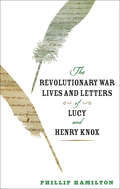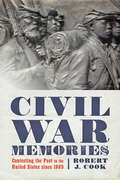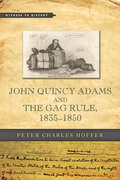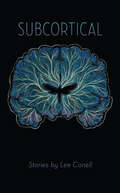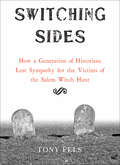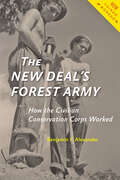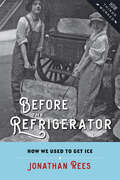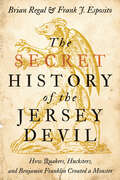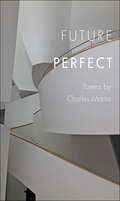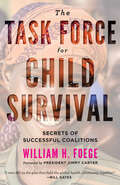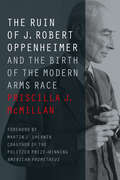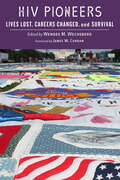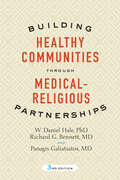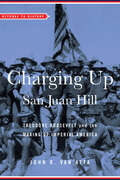- Table View
- List View
The Revolutionary War Lives and Letters of Lucy and Henry Knox
by Phillip HamiltonIn 1774, Boston bookseller Henry Knox married Lucy Waldo Flucker, the daughter of a prominent Tory family. Although Lucy;€™s father was the third-ranking colonial official in Massachusetts, the couple joined the American cause after the Battles of Lexington and Concord and fled British-occupied Boston. Knox became a soldier in the Continental Army, where he served until the war;€™s end as Washington;€™s artillery commander.While Henry is well known to historians, his private life and marriage to Lucy remain largely unexplored. Phillip Hamilton tells the fascinating story of the Knoxes;€™ relationship amid the upheavals of war. Like John and Abigail Adams, the Knoxes were often separated by the revolution and spent much of their time writing to one another. They penned nearly 200 letters during the conflict, more than half of which are reproduced and annotated for this volume.This correspondence;¢;‚¬;€?one of the few collections of letters between revolutionary-era spouses that spans the entire war;¢;‚¬;€?provides a remarkable window into the couple;€™s marriage. Placed at the center of great events, struggling to cope with a momentous conflict, and attempting to preserve their marriage and family, the Knoxes wrote to each other in a direct and accessible manner as they negotiated shifts in gender and power relations. Working together, Henry and Lucy maintained their household and protected their property, raised and educated their children, and emotionally adjusted to other dramatic changes within their family, including a total break between Lucy and her Tory family. Combining original epistles with Hamilton;€™s introductory essays, The Revolutionary War Lives and Letters of Lucy and Henry Knox offers important insights into how this relatable and highly individual couple overcame the war;€™s challenges.
The Revolutionary War Lives and Letters of Lucy and Henry Knox
by Phillip HamiltonIn 1774, Boston bookseller Henry Knox married Lucy Waldo Flucker, the daughter of a prominent Tory family. Although Lucy;€™s father was the third-ranking colonial official in Massachusetts, the couple joined the American cause after the Battles of Lexington and Concord and fled British-occupied Boston. Knox became a soldier in the Continental Army, where he served until the war;€™s end as Washington;€™s artillery commander.While Henry is well known to historians, his private life and marriage to Lucy remain largely unexplored. Phillip Hamilton tells the fascinating story of the Knoxes;€™ relationship amid the upheavals of war. Like John and Abigail Adams, the Knoxes were often separated by the revolution and spent much of their time writing to one another. They penned nearly 200 letters during the conflict, more than half of which are reproduced and annotated for this volume.This correspondence;¢;‚¬;€?one of the few collections of letters between revolutionary-era spouses that spans the entire war;¢;‚¬;€?provides a remarkable window into the couple;€™s marriage. Placed at the center of great events, struggling to cope with a momentous conflict, and attempting to preserve their marriage and family, the Knoxes wrote to each other in a direct and accessible manner as they negotiated shifts in gender and power relations. Working together, Henry and Lucy maintained their household and protected their property, raised and educated their children, and emotionally adjusted to other dramatic changes within their family, including a total break between Lucy and her Tory family. Combining original epistles with Hamilton;€™s introductory essays, The Revolutionary War Lives and Letters of Lucy and Henry Knox offers important insights into how this relatable and highly individual couple overcame the war;€™s challenges.
Civil War Memories: Contesting the Past in the United States since 1865
by Robert J. CookAt a cost of at least 800,000 lives, the Civil War preserved the Union, aborted the breakaway Confederacy, and liberated a race of slaves. Civil War Memories is the first comprehensive account of how and why Americans have selectively remembered, and forgotten, this watershed conflict since its conclusion in 1865. Drawing on an array of textual and visual sources as well as a wide range of modern scholarship on Civil War memory, Robert J. Cook charts the construction of four dominant narratives by the ordinary men and women, as well as the statesmen and generals, who lived through the struggle and its tumultuous aftermath. Part One explains why the Yankee victors;€™ memory of the "War of the Rebellion" drove political conflict into the 1890s, then waned with the passing of the soldiers who had saved the republic. It also touches on the leading role southern white women played in the development of the racially segregated South;€™s "Lost Cause"; explores why, by the beginning of the twentieth century, the majority of Americans had embraced a powerful reconciliatory memory of the Civil War; and details the failed efforts to connect an emancipationist reading of the conflict to the fading cause of civil rights.Part Two demonstrates the Civil War;€™s capacity to thrill twentieth-century Americans in movies such as The Birth of a Nation and Gone with the Wind. It also reveals the war;€™s vital connection to the black freedom struggle in the modern era. Finally, Cook argues that the massacre of African American parishioners in Charleston in June 2015 highlighted the continuing relevance of the Civil War by triggering intense nationwide controversy over the place of Confederate symbols in the United States. Written in vigorous prose for a wide audience and designed to inform popular debate on the relevance of the Civil War to the racial politics of modern America, Civil War Memories is required reading for informed Americans today.
Civil War Memories: Contesting the Past in the United States since 1865
by Robert J. CookAt a cost of at least 800,000 lives, the Civil War preserved the Union, aborted the breakaway Confederacy, and liberated a race of slaves. Civil War Memories is the first comprehensive account of how and why Americans have selectively remembered, and forgotten, this watershed conflict since its conclusion in 1865. Drawing on an array of textual and visual sources as well as a wide range of modern scholarship on Civil War memory, Robert J. Cook charts the construction of four dominant narratives by the ordinary men and women, as well as the statesmen and generals, who lived through the struggle and its tumultuous aftermath. Part One explains why the Yankee victors;€™ memory of the "War of the Rebellion" drove political conflict into the 1890s, then waned with the passing of the soldiers who had saved the republic. It also touches on the leading role southern white women played in the development of the racially segregated South;€™s "Lost Cause"; explores why, by the beginning of the twentieth century, the majority of Americans had embraced a powerful reconciliatory memory of the Civil War; and details the failed efforts to connect an emancipationist reading of the conflict to the fading cause of civil rights.Part Two demonstrates the Civil War;€™s capacity to thrill twentieth-century Americans in movies such as The Birth of a Nation and Gone with the Wind. It also reveals the war;€™s vital connection to the black freedom struggle in the modern era. Finally, Cook argues that the massacre of African American parishioners in Charleston in June 2015 highlighted the continuing relevance of the Civil War by triggering intense nationwide controversy over the place of Confederate symbols in the United States. Written in vigorous prose for a wide audience and designed to inform popular debate on the relevance of the Civil War to the racial politics of modern America, Civil War Memories is required reading for informed Americans today.
John Quincy Adams and the Gag Rule, 1835–1850 (Witness to History)
by Peter Charles HofferPassed by the House of Representatives at the start of the 1836 session, the gag rule rejected all petitions against slavery, effectively forbidding Congress from addressing the antislavery issue until it was rescinded in late 1844. In the Senate, a similar rule lasted until 1850. Strongly supported by all southern and some northern Democratic congressmen, the gag rule became a proxy defense of slavery’s morality and economic value in the face of growing pro-abolition sentiment. In John Quincy Adams and the Gag Rule, 1835–1850, Peter Charles Hoffer transports readers to Washington, DC, in the period before the Civil War to contextualize the heated debates surrounding the rule. At first, Hoffer explains, only a few members of Congress objected to the rule. These antislavery representatives argued strongly for the reception and reading of incoming abolitionist petitions. When they encountered an almost uniformly hostile audience, however, John Quincy Adams took a different tack. He saw the effort to gag the petitioners as a violation of their constitutional rights. Adams’s campaign to lift the gag rule, joined each year by more and more northern members of Congress, revealed how the slavery issue promoted a virulent sectionalism and ultimately played a part in southern secession and the Civil War. A lively narrative intended for history classrooms and anyone interested in abolitionism, slavery, Congress, and the coming of the Civil War, John Quincy Adams and the Gag Rule, 1835–1850, vividly portrays the importance of the political machinations and debates that colored the age.
John Quincy Adams and the Gag Rule, 1835–1850 (Witness to History)
by Peter Charles HofferPassed by the House of Representatives at the start of the 1836 session, the gag rule rejected all petitions against slavery, effectively forbidding Congress from addressing the antislavery issue until it was rescinded in late 1844. In the Senate, a similar rule lasted until 1850. Strongly supported by all southern and some northern Democratic congressmen, the gag rule became a proxy defense of slavery’s morality and economic value in the face of growing pro-abolition sentiment. In John Quincy Adams and the Gag Rule, 1835–1850, Peter Charles Hoffer transports readers to Washington, DC, in the period before the Civil War to contextualize the heated debates surrounding the rule. At first, Hoffer explains, only a few members of Congress objected to the rule. These antislavery representatives argued strongly for the reception and reading of incoming abolitionist petitions. When they encountered an almost uniformly hostile audience, however, John Quincy Adams took a different tack. He saw the effort to gag the petitioners as a violation of their constitutional rights. Adams’s campaign to lift the gag rule, joined each year by more and more northern members of Congress, revealed how the slavery issue promoted a virulent sectionalism and ultimately played a part in southern secession and the Civil War. A lively narrative intended for history classrooms and anyone interested in abolitionism, slavery, Congress, and the coming of the Civil War, John Quincy Adams and the Gag Rule, 1835–1850, vividly portrays the importance of the political machinations and debates that colored the age.
Subcortical (Johns Hopkins: Poetry and Fiction)
by Lee ConellRecipient of the 2018 Story Prize Spotlight AwardLee Conell;€™s linguistically deft stories examine the permeability between the real and the imagined, the stories buried beneath the surface and the stories by which we live our lives. In the title story of this collection, a young woman who wants to become a doctor is manipulated by an older man into playing a role in one of his medical studies. In "The Lock Factory," winner of the Chicago Tribune;€™s 2016 Nelson Algren Literary Award, three women who assemble school combination locks are trapped inside an escalating generational conflict of their own making. A boy who has lost his mother in "The Rent-Controlled Ghost" searches for the spirit of the mistreated tenant who formerly inhabited his apartment. "A Magic Trick for the Recently Unemployed" serves as a three-step how-to guide for reclaiming a sense of self and purpose. In "What the Blob Said to Me," an elderly woman dwells on her long-ago experience working at a government production site for the atomic bomb. And a mother-daughter Groupon for an upscale afternoon tea goes seriously awry in "Mutant at the Pierre Hotel."With humor and verve, Subcortical;€™s dynamic stories delve into the mysteries of the human mind as these haunted characters struggle with economic disparity, educational divides, and the often-contested spaces in which they live.
Subcortical (Johns Hopkins: Poetry and Fiction)
by Lee ConellRecipient of the 2018 Story Prize Spotlight AwardLee Conell;€™s linguistically deft stories examine the permeability between the real and the imagined, the stories buried beneath the surface and the stories by which we live our lives. In the title story of this collection, a young woman who wants to become a doctor is manipulated by an older man into playing a role in one of his medical studies. In "The Lock Factory," winner of the Chicago Tribune;€™s 2016 Nelson Algren Literary Award, three women who assemble school combination locks are trapped inside an escalating generational conflict of their own making. A boy who has lost his mother in "The Rent-Controlled Ghost" searches for the spirit of the mistreated tenant who formerly inhabited his apartment. "A Magic Trick for the Recently Unemployed" serves as a three-step how-to guide for reclaiming a sense of self and purpose. In "What the Blob Said to Me," an elderly woman dwells on her long-ago experience working at a government production site for the atomic bomb. And a mother-daughter Groupon for an upscale afternoon tea goes seriously awry in "Mutant at the Pierre Hotel."With humor and verve, Subcortical;€™s dynamic stories delve into the mysteries of the human mind as these haunted characters struggle with economic disparity, educational divides, and the often-contested spaces in which they live.
Switching Sides: How a Generation of Historians Lost Sympathy for the Victims of the Salem Witch Hunt
by Tony FelsFor most historians living through the fascist and communist tyrannies that culminated in World War II and the Cold War, the Salem witch trials signified the threat to truth and individual integrity posed by mass ideological movements. Work on the trials produced in this era, including Arthur Miller;€™s The Crucible and Marion L. Starkey;€™s The Devil in Massachusetts: A Modern Enquiry into the Salem Witch Trials, left little doubt that most intellectuals;€™ sympathies lay with the twenty innocent victims who stood up to Puritan intolerance by choosing to go to their deaths rather than confess to crimes they had never committed.In Switching Sides, Tony Fels traces a remarkable shift in scholarly interpretations of the Salem witch hunt from the post;€“World War II era up through the present. Fels explains that for a new generation of historians influenced by the radicalism of the New Left in the 1960s and early 1970s, the Salem panic acquired a startlingly different meaning. Determined to champion the common people of colonial New England, dismissive toward liberal values, and no longer instinctively wary of utopian belief systems, the leading works on the subject to emerge from 1969 through the early 2000s highlighted economic changes, social tensions, racial conflicts, and political developments that served to unsettle the accusers in the witchcraft proceedings. These interpretations, still dominant in the academic world, encourage readers to sympathize with the perpetrators of the witch hunt, while at the same time showing indifference or even hostility toward the accused.Switching Sides is meticulously documented, but its comparatively short text aims broadly at an educated American public, for whom the Salem witch hunt has long occupied an iconic place in the nation;€™s conscience. Readers will come away from the book with a sound knowledge of what is currently known about the Salem witch hunt;¢;‚¬;€?and pondering the relationship between works of history and the ideological influences on the historians who write them.
The New Deal's Forest Army: How the Civilian Conservation Corps Worked (How Things Worked)
by Benjamin F. AlexanderPropelled by the unprecedented poverty of the Great Depression, President Franklin D. Roosevelt established an array of massive public works programs designed to provide direct relief to America;€™s poor and unemployed. The New Deal;€™s most tangible legacy may be the Civilian Conservation Corps;€™s network of parks, national forests, scenic roadways, and picnic shelters that still mark the country;€™s landscape. CCC enrollees, most of them unmarried young men, lived in camps run by the Army and worked hard for wages (most of which they had to send home to their families) to preserve America;€™s natural treasures. In The New Deal;€™s Forest Army, Benjamin F. Alexander chronicles how the corps came about, the process applicants went through to get in, and what jobs they actually did. He also explains how the camps and the work sites were run, how enrollees spent their leisure time, and how World War II brought the CCC to its end. Connecting the story of the CCC with the Roosevelt administration;€™s larger initiatives, Alexander describes how FDR;€™s policies constituted a mixed blessing for African Americans who, even while singled out for harsh treatment, benefited enough from the New Deal to become an increasingly strong part of the electorate behind the Democratic Party. The CCC was the only large-scale employment program whose existence FDR foreshadowed in speeches during the 1932 campaign;¢;‚¬;€?and the dearest to his heart throughout the decade that it lasted. Alexander reveals how the work itself left a lasting imprint on the country;€™s terrain as the enrollees planted trees, fought forest fires, landscaped public parks, restored historic battlegrounds, and constructed dams and terraces to prevent floods. A uniquely detailed exploration of life in the CCC, The New Deal;€™s Forest Army compellingly demonstrates how one New Deal program changed America and gave birth to both contemporary forestry and the modern environmental movement.
The New Deal's Forest Army: How the Civilian Conservation Corps Worked (How Things Worked)
by Benjamin F. AlexanderPropelled by the unprecedented poverty of the Great Depression, President Franklin D. Roosevelt established an array of massive public works programs designed to provide direct relief to America;€™s poor and unemployed. The New Deal;€™s most tangible legacy may be the Civilian Conservation Corps;€™s network of parks, national forests, scenic roadways, and picnic shelters that still mark the country;€™s landscape. CCC enrollees, most of them unmarried young men, lived in camps run by the Army and worked hard for wages (most of which they had to send home to their families) to preserve America;€™s natural treasures. In The New Deal;€™s Forest Army, Benjamin F. Alexander chronicles how the corps came about, the process applicants went through to get in, and what jobs they actually did. He also explains how the camps and the work sites were run, how enrollees spent their leisure time, and how World War II brought the CCC to its end. Connecting the story of the CCC with the Roosevelt administration;€™s larger initiatives, Alexander describes how FDR;€™s policies constituted a mixed blessing for African Americans who, even while singled out for harsh treatment, benefited enough from the New Deal to become an increasingly strong part of the electorate behind the Democratic Party. The CCC was the only large-scale employment program whose existence FDR foreshadowed in speeches during the 1932 campaign;¢;‚¬;€?and the dearest to his heart throughout the decade that it lasted. Alexander reveals how the work itself left a lasting imprint on the country;€™s terrain as the enrollees planted trees, fought forest fires, landscaped public parks, restored historic battlegrounds, and constructed dams and terraces to prevent floods. A uniquely detailed exploration of life in the CCC, The New Deal;€™s Forest Army compellingly demonstrates how one New Deal program changed America and gave birth to both contemporary forestry and the modern environmental movement.
Before the Refrigerator: How We Used to Get Ice (How Things Worked)
by Jonathan ReesDuring the late nineteenth and early twentieth centuries, Americans depended upon ice to stay cool and to keep their perishable foods fresh. Jonathan Rees tells the fascinating story of how people got ice before mechanical refrigeration came to the household. Drawing on newspapers, trade journals, and household advice books, Before the Refrigerator explains how Americans built a complex system to harvest, store, and transport ice to everyone who wanted it, even the very poor.Rees traces the evolution of the natural ice industry from its mechanization in the 1880s through its gradual collapse, which started after World War I. Meatpackers began experimenting with ice refrigeration to ship their products as early as the 1860s. Starting around 1890, large, bulky ice machines the size of small houses appeared on the scene, becoming an important source for the American ice supply. As ice machines shrunk, more people had access to better ice for a wide variety of purposes. By the early twentieth century, Rees writes, ice had become an essential tool for preserving perishable foods of all kinds, transforming what most people ate and drank every day. Reviewing all the inventions that made the ice industry possible and the way they worked together to prevent ice from melting, Rees demonstrates how technological systems can operate without a central controlling force. Before the Refrigerator is ideal for history of technology classes, food studies classes, or anyone interested in what daily life in the United States was like between 1880 and 1930.
Before the Refrigerator: How We Used to Get Ice (How Things Worked)
by Jonathan ReesDuring the late nineteenth and early twentieth centuries, Americans depended upon ice to stay cool and to keep their perishable foods fresh. Jonathan Rees tells the fascinating story of how people got ice before mechanical refrigeration came to the household. Drawing on newspapers, trade journals, and household advice books, Before the Refrigerator explains how Americans built a complex system to harvest, store, and transport ice to everyone who wanted it, even the very poor.Rees traces the evolution of the natural ice industry from its mechanization in the 1880s through its gradual collapse, which started after World War I. Meatpackers began experimenting with ice refrigeration to ship their products as early as the 1860s. Starting around 1890, large, bulky ice machines the size of small houses appeared on the scene, becoming an important source for the American ice supply. As ice machines shrunk, more people had access to better ice for a wide variety of purposes. By the early twentieth century, Rees writes, ice had become an essential tool for preserving perishable foods of all kinds, transforming what most people ate and drank every day. Reviewing all the inventions that made the ice industry possible and the way they worked together to prevent ice from melting, Rees demonstrates how technological systems can operate without a central controlling force. Before the Refrigerator is ideal for history of technology classes, food studies classes, or anyone interested in what daily life in the United States was like between 1880 and 1930.
The Secret History of the Jersey Devil: How Quakers, Hucksters, and Benjamin Franklin Created a Monster
by Brian Regal Frank J. EspositoLegend has it that in 1735 a witch named Mother Leeds gave birth to a horrifying monster;¢;‚¬;€?a deformed flying horse with glowing red eyes;¢;‚¬;€?that flew up the chimney of her New Jersey home and disappeared into the Pine Barrens. Ever since, this nightmarish beast has haunted those woods, presaging catastrophe and frightening innocent passersby;¢;‚¬;€?or so the story goes. In The Secret History of the Jersey Devil, Brian Regal and Frank J. Esposito examine the genesis of this popular myth, which is one of the oldest monster legends in the United States.According to Regal and Esposito, everything you think you know about the Jersey Devil is wrong. The real story of the Jersey Devil's birth is far more interesting, complex, and important than most people;¢;‚¬;€?believers and skeptics alike;¢;‚¬;€?realize. Leaving the Pine Barrens, Regal and Esposito turn instead to the varied political and cultural roots of the Devil's creation. Fascinating and lively, this book finds the origins of New Jersey's favorite monster not in witchcraft or an unnatural liaison between woman and devil but in the bare-knuckled political fights and religious upheavals of colonial America. A product of innuendo and rumor, as well as scandal and media hype, the Jersey Devil enjoys a rich history involving land grabs, astrological predictions, mermaids and dinosaur bones, sideshows, Napoleon Bonaparte's brother, a cross-dressing royal governor, and Founding Father Benjamin Franklin.
The Secret History of the Jersey Devil: How Quakers, Hucksters, and Benjamin Franklin Created a Monster
by Brian Regal Frank J. EspositoLegend has it that in 1735 a witch named Mother Leeds gave birth to a horrifying monster;¢;‚¬;€?a deformed flying horse with glowing red eyes;¢;‚¬;€?that flew up the chimney of her New Jersey home and disappeared into the Pine Barrens. Ever since, this nightmarish beast has haunted those woods, presaging catastrophe and frightening innocent passersby;¢;‚¬;€?or so the story goes. In The Secret History of the Jersey Devil, Brian Regal and Frank J. Esposito examine the genesis of this popular myth, which is one of the oldest monster legends in the United States.According to Regal and Esposito, everything you think you know about the Jersey Devil is wrong. The real story of the Jersey Devil's birth is far more interesting, complex, and important than most people;¢;‚¬;€?believers and skeptics alike;¢;‚¬;€?realize. Leaving the Pine Barrens, Regal and Esposito turn instead to the varied political and cultural roots of the Devil's creation. Fascinating and lively, this book finds the origins of New Jersey's favorite monster not in witchcraft or an unnatural liaison between woman and devil but in the bare-knuckled political fights and religious upheavals of colonial America. A product of innuendo and rumor, as well as scandal and media hype, the Jersey Devil enjoys a rich history involving land grabs, astrological predictions, mermaids and dinosaur bones, sideshows, Napoleon Bonaparte's brother, a cross-dressing royal governor, and Founding Father Benjamin Franklin.
Future Perfect (Johns Hopkins: Poetry and Fiction)
by Charles MartinTo be modern is to live not in a single era, but in a churn of new technologies, deep history, myth, literary traditions, and contemporary cultural memes. In Future Perfect, Charles Martin;€™s darkly comic new collection, the poet explores our time and the times that come before and after, which we inhabit and cultivate in memory and imagination. Through poems that play with form and challenge expectation, Martin examines the continuities that persist from time immemorial to the future perfect.Sensitive to the traces left behind by the lives of his characters, Martin follows their tracks, reflections, echoes, and shadows. In "From Certain Footprints Found at Laetoli," an ancient impression preserved in volcanic ash conjures up a family scene three million years past. In "The Last Resort of Mr. Kees" and "Mr. Kees Goes to a Party," Martin adopts the persona of the vanished poet Weldon Kees to reimagine his disappearance. "Letter from Komarovo, 1962" retells the tense real-life meeting between Anna Akhmatova and Robert Frost a year before their nations almost destroyed one another. And in the titular sonnet sequence that ends the book, Martin conjures a childhood in the Bronx under the shadow of the mushroom cloud of nuclear war as the perfected future supplanting the present.Introducing Buck Rogers to Randall Jarrell and combining new translations or reinterpretations of works by Ovid, G. G. Belli, Octavio Paz, and Euripides, Future Perfect further establishes Charles Martin as a master of invention.
Future Perfect (Johns Hopkins: Poetry and Fiction)
by Charles MartinTo be modern is to live not in a single era, but in a churn of new technologies, deep history, myth, literary traditions, and contemporary cultural memes. In Future Perfect, Charles Martin;€™s darkly comic new collection, the poet explores our time and the times that come before and after, which we inhabit and cultivate in memory and imagination. Through poems that play with form and challenge expectation, Martin examines the continuities that persist from time immemorial to the future perfect.Sensitive to the traces left behind by the lives of his characters, Martin follows their tracks, reflections, echoes, and shadows. In "From Certain Footprints Found at Laetoli," an ancient impression preserved in volcanic ash conjures up a family scene three million years past. In "The Last Resort of Mr. Kees" and "Mr. Kees Goes to a Party," Martin adopts the persona of the vanished poet Weldon Kees to reimagine his disappearance. "Letter from Komarovo, 1962" retells the tense real-life meeting between Anna Akhmatova and Robert Frost a year before their nations almost destroyed one another. And in the titular sonnet sequence that ends the book, Martin conjures a childhood in the Bronx under the shadow of the mushroom cloud of nuclear war as the perfected future supplanting the present.Introducing Buck Rogers to Randall Jarrell and combining new translations or reinterpretations of works by Ovid, G. G. Belli, Octavio Paz, and Euripides, Future Perfect further establishes Charles Martin as a master of invention.
The Task Force for Child Survival: Secrets of Successful Coalitions
by William W. FoegeDr. Bill Foege, one of the best-known names in global health, brings readers to the table during the creation of one of the world;€™s most famous and successful global health efforts;¢;‚¬;€?the Task Force for Child Survival.In 1984, the US immunization program was so successful that many childhood diseases were at record lows;¢;‚¬;€?yet 40,000 children a day were dying around the world from preventable diseases. That year, Dr. Foege, former director of the Centers for Disease Control and Prevention, came together with Jonas Salk, Robert McNamara, and representatives from UNICEF, the World Health Organization, the World Bank, the United Nations Development Programme, and the Rockefeller Foundation to see how some of the lessons learned in America could be applied to global programs. The assembled participants recommended the formation of a small task force to help UN agencies improve immunization coverage. They dubbed it the Task Force for Child Survival and installed Foege as its first leader.In this book, Dr. Foege describes the task force from its conception through its landmark success. Over its first six years, as more resources were allocated to the task force, immunization coverage climbed from approximately 15 percent of the world;€™s children for some vaccines to 80 percent of the world;€™s children for at least one vaccine. UNICEF head Jim Grant called it the greatest peacetime endeavor the world had ever seen. How did this small, independent, low-profile group leverage change in the largest of global health agencies? Foege dissects each element for clues as to why the task force was able to accomplish so much so quickly, ultimately concluding that coalition-building played a major role and explaining how to strengthen coalitions by scrupulously avoiding the turf guarding and credit seeking that are so common to international endeavors.Inspiring and accessible, this brief book combines the distilled advice of one of global health's major leaders with the history of an iconic public health program.
The Task Force for Child Survival: Secrets of Successful Coalitions
by William W. FoegeDr. Bill Foege, one of the best-known names in global health, brings readers to the table during the creation of one of the world;€™s most famous and successful global health efforts;¢;‚¬;€?the Task Force for Child Survival.In 1984, the US immunization program was so successful that many childhood diseases were at record lows;¢;‚¬;€?yet 40,000 children a day were dying around the world from preventable diseases. That year, Dr. Foege, former director of the Centers for Disease Control and Prevention, came together with Jonas Salk, Robert McNamara, and representatives from UNICEF, the World Health Organization, the World Bank, the United Nations Development Programme, and the Rockefeller Foundation to see how some of the lessons learned in America could be applied to global programs. The assembled participants recommended the formation of a small task force to help UN agencies improve immunization coverage. They dubbed it the Task Force for Child Survival and installed Foege as its first leader.In this book, Dr. Foege describes the task force from its conception through its landmark success. Over its first six years, as more resources were allocated to the task force, immunization coverage climbed from approximately 15 percent of the world;€™s children for some vaccines to 80 percent of the world;€™s children for at least one vaccine. UNICEF head Jim Grant called it the greatest peacetime endeavor the world had ever seen. How did this small, independent, low-profile group leverage change in the largest of global health agencies? Foege dissects each element for clues as to why the task force was able to accomplish so much so quickly, ultimately concluding that coalition-building played a major role and explaining how to strengthen coalitions by scrupulously avoiding the turf guarding and credit seeking that are so common to international endeavors.Inspiring and accessible, this brief book combines the distilled advice of one of global health's major leaders with the history of an iconic public health program.
The Ruin of J. Robert Oppenheimer: And the Birth of the Modern Arms Race (Johns Hopkins Nuclear History and Contemporary Affairs)
by Priscilla J. McMillanOn April 12, 1954, the nation was astonished to learn that J. Robert Oppenheimer was facing charges of violating national security. Could the director of the Manhattan Project, the visionary who led the effort to build the atom bomb, really be a traitor? In this riveting book, bestselling author Priscilla J. McMillan draws on newly declassified U.S. government documents and materials from Russia, as well as in-depth interviews, to expose for the first time the conspiracy that destroyed one of America;€™s most illustrious scientists.McMillan recreates the fraught years from 1949 to 1955 when Oppenheimer and a group of liberal scientists tried to head off the cabal of hard-line air force officials, anti-Communist politicians, and rival scientists, including physicist Edward Teller, who were trying to seize control of U.S. policy and build ever more deadly nuclear weapons. Retelling the story of Oppenheimer;€™s trial, which took place in utmost secrecy, she describes how the government made up its own rules and violated many protections of the rule of law. She also argues that the effort to discredit Oppenheimer, occurring at the height of the McCarthy era and sanctioned by a misinformed President Eisenhower, was a watershed in the Cold War, poisoning American politics for decades and creating dangers that haunt us today.A chilling tale of McCarthy-era machinations, this groundbreaking page-turner rewrites the history of the Cold War.
HIV Pioneers: Lives Lost, Careers Changed, and Survival
by Wendee M. Wechsberg James W. CurranTremendous strides have been made in the prevention and treatment of HIV since the disease first appeared in the 1980s. But because many of the people who studied and battled the virus in those early days are now gone, firsthand accounts are at risk of being lost. In HIV Pioneers, Wendee M. Wechsberg collects 29 "first stories" from the outset of the AIDS epidemic. These moving personal narratives and critical historical essays not only shed light on the experiences of global health pioneers, prominent scientists, and HIV survivors, but also preserve valuable lessons for managing the risk and impact of future epidemics.With unprecedented access to many key actors in the fight against AIDS and HIV, Wechsberg brings to life the harrowing reality of those early days of the epidemic. The book captures the experiences of those still working diligently and innovatively in the field, elevating the voices of doctors, scientists, and government bureaucrats alongside those of survivors and their loved ones. Focusing on the impact that the epidemic had on careers, pieces also show how governments responded to HIV, how research agendas were developed, and how AIDS service agencies and case management evolved.Illuminating the multiple facets of the HIV epidemic, both in the United States and across the globe, HIV Pioneers is a touching and inspirational look into the ongoing fight against HIV.Contributors: Quarraisha Abdool Karim, Salim S. Abdool Karim, Lynda Arnold, Anne Jeanene Bengoa, Robert E. Booth, Barry S. Brown, Thomas Coates, Francine Cournos, James W. Curran, Don C. Des Jarlais, Jeffrey D. Fisher, William A. Fisher, Samuel R. Friedman, Robert C. Gallo, Mary Guinan, Gibbie Harris, Warren W. Hewitt Jr., Susan M. Kegeles, Rayford Kytle, Bishop Stacey S. Latimer, Robert Love, Duane C. McBride, Clyde B. McCoy, Carmen Morris, Willo Pequegnat, Mary Jane Rotheram-Borus, Jeffrey Samet, David Serwadda, Lorraine Sherr, James L. Sorensen, Jack B. Stein, Charles van der Horst, Wendee M. Wechsberg, Wayne Wiebel, William A. Zule
HIV Pioneers: Lives Lost, Careers Changed, and Survival
by Wendee M. Wechsberg James W. CurranTremendous strides have been made in the prevention and treatment of HIV since the disease first appeared in the 1980s. But because many of the people who studied and battled the virus in those early days are now gone, firsthand accounts are at risk of being lost. In HIV Pioneers, Wendee M. Wechsberg collects 29 "first stories" from the outset of the AIDS epidemic. These moving personal narratives and critical historical essays not only shed light on the experiences of global health pioneers, prominent scientists, and HIV survivors, but also preserve valuable lessons for managing the risk and impact of future epidemics.With unprecedented access to many key actors in the fight against AIDS and HIV, Wechsberg brings to life the harrowing reality of those early days of the epidemic. The book captures the experiences of those still working diligently and innovatively in the field, elevating the voices of doctors, scientists, and government bureaucrats alongside those of survivors and their loved ones. Focusing on the impact that the epidemic had on careers, pieces also show how governments responded to HIV, how research agendas were developed, and how AIDS service agencies and case management evolved.Illuminating the multiple facets of the HIV epidemic, both in the United States and across the globe, HIV Pioneers is a touching and inspirational look into the ongoing fight against HIV.Contributors: Quarraisha Abdool Karim, Salim S. Abdool Karim, Lynda Arnold, Anne Jeanene Bengoa, Robert E. Booth, Barry S. Brown, Thomas Coates, Francine Cournos, James W. Curran, Don C. Des Jarlais, Jeffrey D. Fisher, William A. Fisher, Samuel R. Friedman, Robert C. Gallo, Mary Guinan, Gibbie Harris, Warren W. Hewitt Jr., Susan M. Kegeles, Rayford Kytle, Bishop Stacey S. Latimer, Robert Love, Duane C. McBride, Clyde B. McCoy, Carmen Morris, Willo Pequegnat, Mary Jane Rotheram-Borus, Jeffrey Samet, David Serwadda, Lorraine Sherr, James L. Sorensen, Jack B. Stein, Charles van der Horst, Wendee M. Wechsberg, Wayne Wiebel, William A. Zule
Building Healthy Communities through Medical-Religious Partnerships
by W. Daniel Hale Richard G. Bennett Panagis GaliatsatosBecause health care works best when patients assume greater responsibility for their own health, community outreach and patient education are essential. But where can health care organizations find the resources to educate large numbers of people about chronic diseases? How can they tailor programs to meet the needs of increasingly diverse communities? And how can they reach people who have no ties to the health care system? Building Healthy Communities through Medical-Religious Partnerships presents an innovative approach to community-based health education and patient advocacy programs targeted at the prevention and management of disease. Offering valuable guidance for religious and medical leaders interested in developing programs in their congregations and communities, the book includes practical and accessible information for establishing health education programs, identifies additional resources that can be obtained from local and national organizations, and discusses a range of medical topics. It also outlines how to train volunteers to assist others in navigating our complex health system. This latest edition, which has been thoroughly revised and updated, incorporates;€¢ new chapters on medical topics across the lifespan, including lung disease, kidney disease, and child and adolescent health issues;;€¢ a thorough assessment of medical-religious partnerships that have emerged over the past twenty-five years; and;€¢ a user-friendly website with downloadable resources;¢;‚¬;€?including an instructor's guide, PowerPoint slides, and ready-made handouts.
Building Healthy Communities through Medical-Religious Partnerships
by W. Daniel Hale Richard G. Bennett Panagis GaliatsatosBecause health care works best when patients assume greater responsibility for their own health, community outreach and patient education are essential. But where can health care organizations find the resources to educate large numbers of people about chronic diseases? How can they tailor programs to meet the needs of increasingly diverse communities? And how can they reach people who have no ties to the health care system? Building Healthy Communities through Medical-Religious Partnerships presents an innovative approach to community-based health education and patient advocacy programs targeted at the prevention and management of disease. Offering valuable guidance for religious and medical leaders interested in developing programs in their congregations and communities, the book includes practical and accessible information for establishing health education programs, identifies additional resources that can be obtained from local and national organizations, and discusses a range of medical topics. It also outlines how to train volunteers to assist others in navigating our complex health system. This latest edition, which has been thoroughly revised and updated, incorporates;€¢ new chapters on medical topics across the lifespan, including lung disease, kidney disease, and child and adolescent health issues;;€¢ a thorough assessment of medical-religious partnerships that have emerged over the past twenty-five years; and;€¢ a user-friendly website with downloadable resources;¢;‚¬;€?including an instructor's guide, PowerPoint slides, and ready-made handouts.
Charging Up San Juan Hill: Theodore Roosevelt and the Making of Imperial America (Witness to History)
by John R. Van AttaBelow a Cuban sun so hot it stung their eyes, American troops hunkered low at the base of Kettle Hill. Spanish bullets zipped overhead, while enemy artillery shells landed all around them. Driving Spanish forces from the high ground would mean gaining control of Santiago, Cuba, and, soon enough, American victory in the Spanish-American War. No one doubted that enemy fire would claim a heavy toll, but these unusual citizen-soldiers and their unlikely commander;¢;‚¬;€?39-year-old Colonel Theodore Roosevelt;¢;‚¬;€?had volunteered for exactly this kind of mission.In Charging Up San Juan Hill, John R. Van Atta recounts that fateful day in 1898. Describing the battle;€™s background and its ramifications for Roosevelt, both personal and political, Van Atta explains how Roosevelt;€™s wartime experience prompted him to champion American involvement in world affairs. Tracking Roosevelt;€™s rise to the presidency, this book argues that the global expansion of American influence;¢;‚¬;€?indeed, the building of an empire outward from a strengthened core of shared values at home;¢;‚¬;€?connected to the broader question of cultural sustainability as much as it did to the increasing of trade, political power, and military might.At the turn of the twentieth century, Theodore Roosevelt personified American confidence. A New York City native and recovered asthmatic who spent his twenties in the wilds of the Dakota Territory, Roosevelt leapt into the war with Spain with gusto. He organized a band of cavalry volunteers he called the Rough Riders and, on July 1, 1898, took part in their charge up a Cuban hill the newspapers called San Juan, launching him to national prominence. Without San Juan, Van Atta argues, Roosevelt;¢;‚¬;€?whom the papers credited for the victory and lauded as a paragon of manhood;¢;‚¬;€?would never have reached a position to become president.
